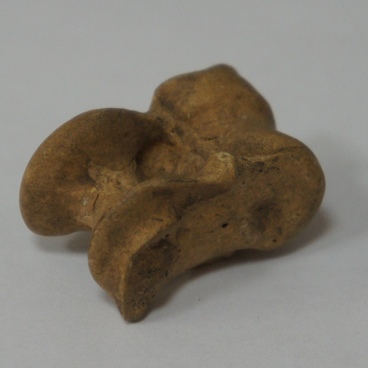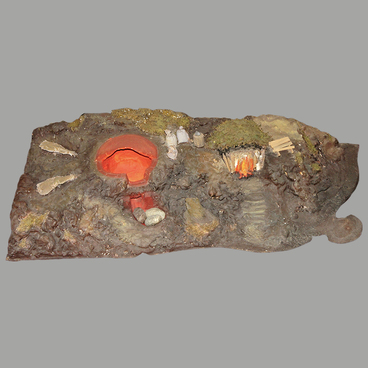Pot-shaped bead is a type of female jewelry. It was found in Novokuznetsk, on the edge of the right beach terrace of the river Tom, in 54 m from the water edge, opposite the mouth of the river Aba (Upper Ostrovsky District), as part of the Ust-Abinsk burial ground. Archaeologists investigated an area of about 600 square meters, on which 14 graves of the Fominsk culture with evidence of memorial rites were discovered. A number of graves were lost as a result of contemporary economic activities. The area of the site was blocked by a dump from a nearby clay quarry with a thickness of 0.5 to 1.5 m. The surviving part of the burial ground was discovered and completely excavated. Ust-Abinsk burial ground is a pearl of the archaeological heritage of the Kuznetsk land. The burial ground artifacts include some white bronze objects that have high artistic merit and reflect religious representations of people of that era, namely the cult of the bear and the cult of Mithra (images of horsemen and water birds). Some artifacts made of gold, such as gold foil, sewed-on pieces and earrings were also discovered in the burial ground. It should be noted that all of these items most likely found the way into the territory of Kuznetsk land from the Urals, in the process of exchange trade.
Among paired compositions found in Fominsk burial site, paired pot-shaped beads have special importance. They are always included in rich sets of bronze jewelry, which can be presumably associated with women’s graves.
The artifact was made in the second quarter of the 1st millennium AD, which was the final stage of the Hun-Sarmatian era. For many steppe and forest-steppe regions of Eurasia, it was a time of troubles. Collapse of ancient cultures, desolation of lands, and drastic changes in cultural traditions were among the features of the era called Great Migration period. Even though this term was introduced to indicate a specific period in the history of Europe, it perfectly matches the characteristic of ethnic and cultural disasters of the first half of the 1st millennium at the most remote eastern outskirts of Eurasian steppe territory.
Among paired compositions found in Fominsk burial site, paired pot-shaped beads have special importance. They are always included in rich sets of bronze jewelry, which can be presumably associated with women’s graves.
The artifact was made in the second quarter of the 1st millennium AD, which was the final stage of the Hun-Sarmatian era. For many steppe and forest-steppe regions of Eurasia, it was a time of troubles. Collapse of ancient cultures, desolation of lands, and drastic changes in cultural traditions were among the features of the era called Great Migration period. Even though this term was introduced to indicate a specific period in the history of Europe, it perfectly matches the characteristic of ethnic and cultural disasters of the first half of the 1st millennium at the most remote eastern outskirts of Eurasian steppe territory.


